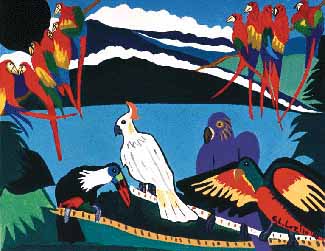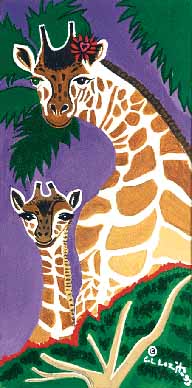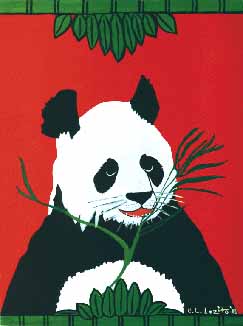by Chris Klein
![]() his months cover,
and the colorful images on this page, are the work of artist Carol
Lozito. Her vibrant, colorful contemporary wildlife paintings
display a unique style that has been compared with the great French
artist Henri Rousseau.
his months cover,
and the colorful images on this page, are the work of artist Carol
Lozito. Her vibrant, colorful contemporary wildlife paintings
display a unique style that has been compared with the great French
artist Henri Rousseau.
"I wanted to bring public
awareness to the plight of endangered animals. People should know
how few are left," she said. "So, a few years ago I
started painting endangered species."
Now, you can see her work in person at the window display of the
U.S. Grant Hotel, C Street side, in downtown San Diego.This year
she also has had major exhibitions at the FACT Gallery in South
Laguna Beach and at the Rancho Carmel Gallery in San Diego.
Art has always been a part
of Carol's life. Her father, an artist, first taught her to draw
when she was five. The goal of becoming a children's book illustrator
took her to arts school at The School of Visual Arts in New York
City. In 1973 she moved to the west coast to attend The Academy
of Arts College in San Francisco where she majored in children's
illustration and fashion. After school, she said she moved to
San Diego, "because I liked the weather."
An emerging artist, Carol is
looking for a publisher with a concern for the environment to
market her work. If you can help this marvelous artist, or are
interested in purchasing artwork or prints, please contact please
call 619-515-1782; PMB 74, 300 Carlsbad Village Dr. #108-A; Carlsbad,
CA 92008-2999. She is currently exhibiting at:Wild Women Arts,
41-801 Corporate Way, #12, Palm Desert, CA; and Casino Gallery,
Catalina Island, CA (Avalon).

Red
and green macaws, toucans and cockatoos. From 100 macaw pairs
as few as 6 chicks fledge each year. Habitat loss, hunting for
food and feathers, and pet trade are a triple threat.

Mother
and baby Rothschild giraffe. Fewer than 200 live in Kenya, and
fewer than 900 still survive in the Kidepo Valley National Park
in Uganda.

The
giant panda's soliratary nature, unusual breeding cycle and scarse
food supply have made it difficult to save the approximately 1000
remaining in the wild.